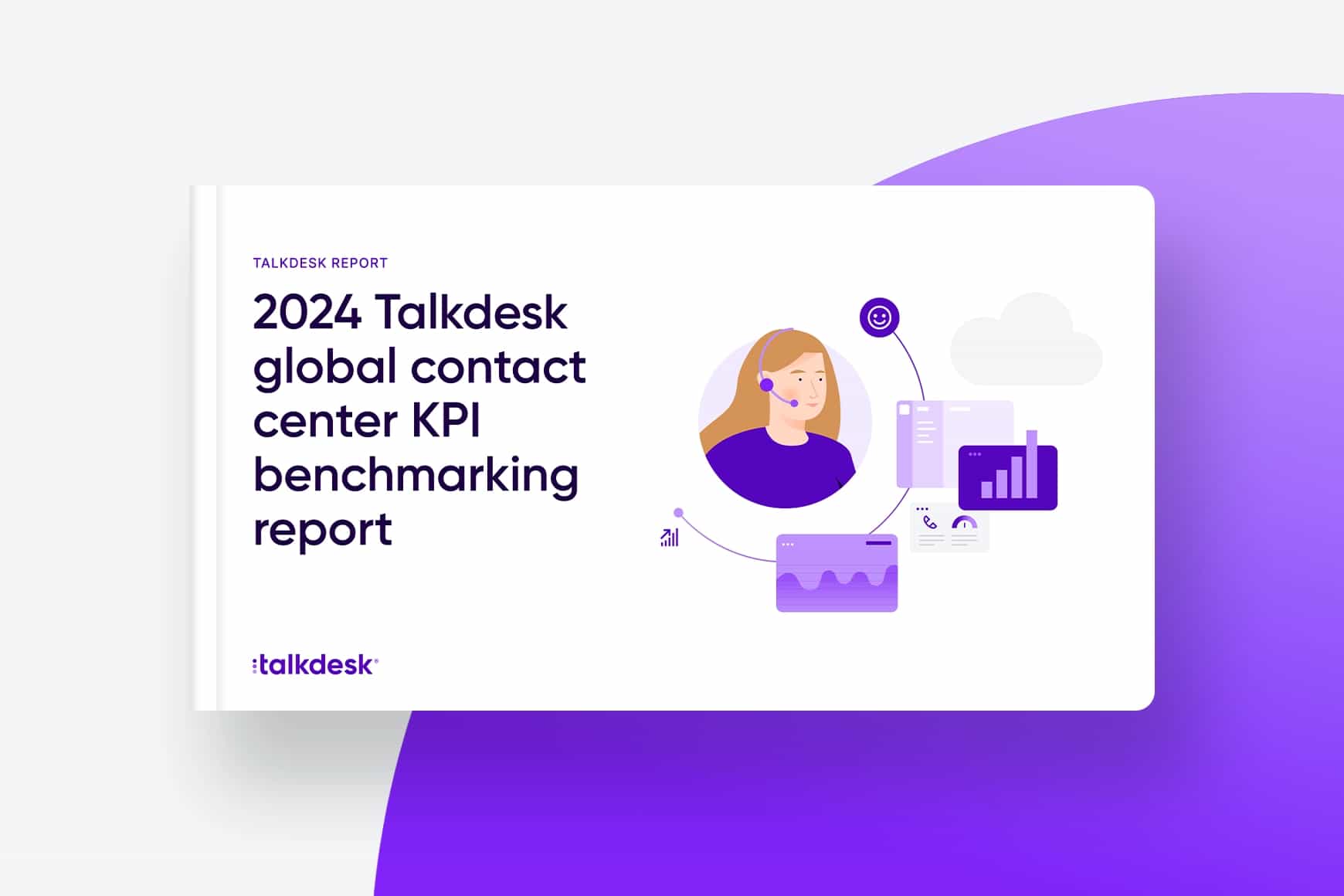First call resolution (FCR): What it is and how to improve it

By Celia Cerdeira
0 min read

First call resolution (FCR) tracks whether a customer’s issue is fully resolved during their first interaction, no follow-up required.
It’s a critical metric that reflects how well your support team delivers fast, effective help, directly influencing customer satisfaction and overall contact center performance.
Even with the growth of digital channels, many customers still turn to phone support for more complex or time-sensitive concerns. When those calls don’t result in immediate answers, frustration builds and trust erodes. A high FCR rate, on the other hand, signals a smooth, efficient experience that leaves customers feeling heard and helped.
In this article, we’ll explore how to measure, benchmark, and improve first call resolution, including how AI-powered solutions can help increase resolution rates.
What is first call resolution (FCR)?
First call resolution (FCR) measures how often a customer service team resolves issues in the first contact. More than just a performance stat, first call resolution reflects great customer relationship management. Resolving issues on the first try builds trust and loyalty, showing customers that their time is respected and their concerns matter.
First call resolution vs first contact resolution: what’s the difference?
While the terms first call resolution and first contact resolution sound similar—and are often used interchangeably—they refer to two distinct metrics. Let’s start with a quick definition of each.
First call resolution (FCR) refers specifically to phone interactions. On the other hand, first contact resolution takes a broader view. It tracks the percentage of customer issues resolved during the first interaction across any channel—whether it’s a phone call, live chat, email, SMS, or social message.
Both metrics aim to measure efficiency and customer satisfaction, but contact resolution gives a more complete picture of how well a company handles inquiries.

Talkdesk Report
Talkdesk 2024 KPI benchmarking report for contact centers
Get a snapshot of your contact center’s performance in the age of agentic AI, see how it compares to industry peers, and discover tips for optimization.
How to measure first call resolution rate.
A company can calculate first call resolution using this formula:
-
Divide the number of customer issues resolved on the first call by the total number of customer issues.
-
Multiply the answer by 100% to achieve a percentage.
The way a company defines “resolved” can impact results. For example, it can adjust FCR calculations to exclude reopened cases, where customers call back about the same issue within a set timeframe. Tracking these cases separately helps identify recurring issues, assess agent performance, and refine resolution strategies.
What is a good first call resolution rate?
Studies show that a good industry standard for first call resolution rate is above 70%. Improving FCR delivers tangible benefits, including:
-
Lower operational costs. Fewer repeat calls mean less time and fewer resources spent resolving the same issue more than once.
-
Higher customer satisfaction. Fast, one-touch resolutions make for happier, more loyal customers who are more likely to recommend your company.
-
Boosted agent morale. Agents feel more productive and less frustrated when they can successfully resolve issues without escalation.
-
Greater capacity. With fewer follow-ups clogging the queue, teams can handle a higher volume of unique customer interactions.
-
Improved first impressions. Resolving problems on the first call builds immediate credibility and reinforces your company’s reliability.
-
Better data quality. Efficient resolutions tend to generate cleaner, more accurate documentation, which supports long-term insights and continuous improvement.
A company should track FCR as part of a wider set of vital metrics for customer success. Some good KPIs to monitor for customer satisfaction include:
-
Net promoter score (NPS) measures customer loyalty through the likelihood they’ll recommend a service to others. Happy customers are often the best marketers.
-
Customer satisfaction score (CSAT) describes how happy customers are with specific interactions, like a technical support phone call. The data is usually gathered by post-interaction surveys and scores.
-
Customer effort score (CES) reveals how hard a customer has to work for a solution. The easier a solution, the less effort a customer spends on it, and the happier they are likely to be.
Each of these metrics contributes to overall customer sentiment. By prioritizing these KPIs, companies can drive noticeable improvement in the quality of their customer experience.
How to improve first call resolution rate.
The key to achieving high FCR lies in well-trained agents, AI-powered support, and smart call routing. Let’s look at some of the steps a contact center can take to improve FCR.
Train agents to resolve issues efficiently.
Training equips contact center agents with the knowledge and skills to solve the issue on the first contact and improve customer satisfaction.
Agent training should emphasize active listening, problem-solving, and deep product knowledge to improve issue resolution. AI-powered learning systems can personalize training based on agent performance, while real-time AI recommendations help agents during live calls.
Deploy agent-assist AI that makes agents even more effective.
AI-driven solutions boost FCR by providing agents with faster, more accurate insights during live calls, ensuring they have the right information at the right time. AI-powered agent assistants can improve FCR in several ways:
-
Automatic knowledge retrieval instantly surfaces relevant content, articles, and solutions to better assist agents during communications.
-
Customer interaction history provides agents with a complete history of a customer’s previous interactions across all available communication channels. This also enables agents to provide a more personalized customer experience, referencing previous discussions or talking points if useful.
-
Customer sentiment analysis gauges customers’ emotional tones during conversations and makes suggestions on how to handle the situation, enabling agents to empathize with customers.
-
Next-best action suggestions proactively give agents the next-best action recommendations for each stage of the conversation.
-
Automated follow-ups and feedback surveys confirm issue resolution.
Connect customers to agents skilled in specific areas.
Intelligent call routing connects customers with agents best equipped to handle their specific issue, reducing transfers and improving first call resolution rates.
By analyzing previous interactions and intents, AI-powered routing determines whether to direct a caller to a specialized agent or a self-service tool for faster resolution.
Beyond improving FCR, intelligent routing also enhances:
-
Average handle time (AHT). Delivering calls to the most appropriate agents cuts the need for multiple transfers.
-
Customer service level (CSL). Handling calls quickly and efficiently usually leads to happier customers. A high level of successful service is essential to driving customer satisfaction and loyalty.
Develop a deep knowledge base of common customer issues and resolutions.
A knowledge base serves as a central repository of information about products, services, and common customer issues. Giving agents access to this library allows them to quickly find accurate solutions to customer questions, significantly increasing FCR performance.
An AI-powered knowledge base goes one step further by making real-time suggestions to agents during calls. By analyzing the conversation, AI can surface answers from the knowledge base or point agents to useful information, like previous successful fixes or a troubleshooting manual.
Companies can build powerful knowledge bases by collecting data from customer interactions, agent feedback, and product teams.
The most effective knowledge base solutions share features, such as:
-
Search functionality. This allows agents to intuitively find solutions using natural language queries.
-
Categorization. Organizing and tagging information makes it easier to group related content and guides for simple navigation.
-
Version control. Track updates and monitor changes so documentation and information stay current, or previous iterations can be returned to if required.
-
Language support. Many companies do business globally. Multilingual support can benefit agents and customers in multinational organizations.
-
Analytics. Analytical data on most-viewed articles or commonly asked questions can help a company understand the problems customers are facing and turn those learnings into actionable insights.
-
Customization. These tools enable an out-of-the-box knowledge base solution to be rebranded with company colors or logos.
-
Omnichannel integration. Many customers use multiple communication channels to interact with a company, such as social media pages or live chat. Ensure any knowledge base is accessible through or interacts with multiple platforms.
-
Internal collaboration. Employee collaboration ensures staff across the company can lend their expertise to building out information sources.
A well-maintained knowledge base not only empowers agents to resolve issues more efficiently but also forms the foundation for self-service options that further improve the customer experience.
First call resolution best practices.
Improving FCR starts with the right strategies, tools, and team mindset. Here are some best practices to help contact centers consistently resolve issues on the first try:
-
Enable cross-functional collaboration. Make it easy for agents to connect with other teams (like tech support or billing) in real time when a case needs extra input.
-
Leverage CRM and call history tools. Give agents context from previous interactions so customers don’t have to repeat themselves.
-
Encourage active listening. Teaching agents to fully understand the issue before jumping to solutions helps prevent misunderstandings and repeat calls.
-
Use AI-powered suggestions. AI tools can help deliver real-time next-best-action recommendations and call scripting guidance.
-
Identify repeat call drivers. Regularly analyze common reasons for follow-up calls, like billing issues, unclear instructions, or shipping delays, to proactively address and reduce them.
-
Establish clear escalation procedures. Define when and how agents should escalate issues to ensure efficient handoffs and minimize repeat contacts.
Optimize FCR for customer satisfaction.
Strong first call resolution isn’t just a performance metric; it’s a key driver of customer satisfaction, efficiency, and cost savings. Resolving issues quickly and effectively improves customer loyalty, reduces operational strain, and enhances overall service quality.
However, speed alone isn’t enough. Rushing through calls can lead to incomplete solutions and repeat calls, undermining the very goal of FCR. The key is balancing efficiency with accuracy and ensuring agents have the right tools.
AI-powered customer service solutions help strike this balance with real-time insights, intelligent routing, and automation. The Talkdesk AI-powered CX solution helps a contact center to boost FCR, optimize agent performance, and enhance the customer experience.
To learn more about FCR and other important contact center metrics, read our deep dive on KPI benchmarks.
First call resolution rate FAQs.
Find answers to common questions about first call resolution rate.
First call resolution (FCR) rate is a percentage value that determines the number of customer issues that are solved in the first call. It’s a key performance indicator that can help a company understand the efficacy of its customer service department.
FCR is calculated using the following formula: (Number of customer issues resolved by first contact ÷ Total number of calls) × 100 = FCR (%)
A good FCR value is usually 70% and above. This means 70% of customer queries are resolved within the first call.
FCR is an important metric for determining the effectiveness of a company’s customer service department. Resolving customer issues quickly is likely to lead to happier and more loyal customers. High first call resolution can also cut down on operational costs, increase agent performance, and improve staff morale.
Improving FCR requires a smart mix of agent training, AI-powered support, and process optimization. Start by training agents to strengthen their product knowledge, active listening, and problem-solving skills. Pair that with AI assistance that delivers real-time insights, automated knowledge retrieval, and suggested next-best actions during live interactions.







